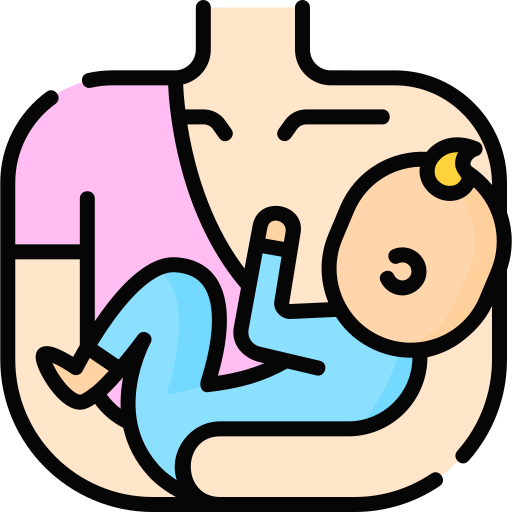Babies are sensitive creatures, and most of the time, you have to aid them with standard procedures that aid their growth. For example, holding a baby upright after feeding is common as it helps with digestion. It enables the air bubbles in their digestive tract to get released from the body.
These small things decrease spit-up by ensuring that the baby burps properly after feeding time. So, how long should you keep them upright, and when should you stop? Let’s find out.
Key Notes
- You can keep your baby upright for ten to fifteen minutes after feeding
- If they have GERD, you can hold them for an hour or more
- After babies turn one year, they don’t spit up as much or at all
- Get a swing or bouncer to help you with this process
Keeping Baby Upright After Feeding: How Long Should You Do It?
Timing is crucial because if you put down your baby quickly after feeding them, it might boost their spit and gastric reflux.
We recommend that you keep your baby upright for a minimum of ten to fifteen minutes after you have fed them.
Such timing will provide them with enough time for their stomach to settle down.
It will also ensure that your baby burps with ease. But this might not always be the case.
If your baby is spitting up even after fifteen minutes, then we suggest you keep them upright for about 30 minutes. Finally, if your baby has a gastrointestinal condition such as esophagitis or GERD, then you might need to hold them upright for around 1 hour or more.
So, how long you can keep your baby upright also depends on your baby. Make sure to keep these factors in mind before you decide on a perfect time for them.
What To Do If Baby Still Spits Up After Being Upright?
You have been doing everything you are told and keeping your baby upright after every feeding session. Yet, they still spit up, and you don’t know what to do.
Remember that this is not an issue unless your baby starts showing the following symptoms:
- They have constipation issues
- Challenges with putting on weight
- Spitting or vomiting forcefully
- Appetite loss
- Dehydration
If you notice any of the above mentioned symptoms in your baby, it is time to take them to their healthcare provider. They will assess the health of your child and recommend treatments based on what they need.
These can range anywhere from feeding smaller meals to using feed thickeners for formula or breast milk.
When You Can Stop Holding Your Newborn Upright After Feeding
Now that you understand how long it takes to hold the baby, it is just as important to know when it is time to let this process go.
But this depends on your baby because everyone has different timelines for their digestive muscles to become mature.
However, most babies will not be spitting up by the time they are one year old.
Most babies will have good control of their body’s esophageal sphincter between four and six months.
If you notice your baby has stopped spitting up or if they are spitting less than before, it is time for you to stop holding them upright after feeding.
Top Burping Positions You Can Try To Help Burp Your Baby
Burping is a crucial part of holding the baby right after they are fed. There are different methods you can use to make this happen.
Not every method will work for each baby, so you have to find what works for yours.
Here are the top positions you can try to help burp your baby:
- Holding Them To Your Chest
This is the most common position that almost all mothers use. It is where you keep the baby’s chin on one of your shoulders, and you hold them with one hand. You can use the other hand to then pat their back.
If you want to make this even better for your baby, you can always sit in a rocking chair to gently rock your baby. Babies love motions, especially rocking and swinging, which is why this can also help them burp and feel comfortable.
- Sit Up And Hold Your Baby
Another position you can try is to sit up and hold your baby by supporting their chest and head with one hand and their back with the other.
You can cradle their chin in your hand as the heel of your hand rests on their chests. Be careful not to keep the hand on their throat, as this can hinder the burping process.
Your other hand should be on their back. Pat or rub their back to aid with burping. Doing this will allow them to burp in no time.
- Lay Them Belly Down
Finally, you can opt for this position by following these steps:
- Lay your baby’s belly down on your knees
- Support their head with your hands
- Make sure the head is higher than the chest
- Use your other hand to pat their back gently. You can also rub the back instead of patting it.
Not everyone likes this position, and you can try and see whether your baby responds to this.
Can You Use A Swing Or Bouncer To Burp Your Baby?
Finally, it can be exhausting to hold the baby for a long time after you have fed them. This is why many mothers think of using a bouncer or swing to aid this process.
Yes, you can use it, and it will give your arms the break that they need.
Just make sure that you don’t leave your baby to sleep in it in an upright position. Only do this if your pediatrician has already suggested this to you.
Final Thoughts
We hope this guide was helpful in understanding how long you can keep your baby upright after feeding and when you can stop.
It is important to keep them upright for ten to fifteen minutes and stop after a certain age. Everything will depend on your baby and their responses, so it will vary between each baby and parent.




























